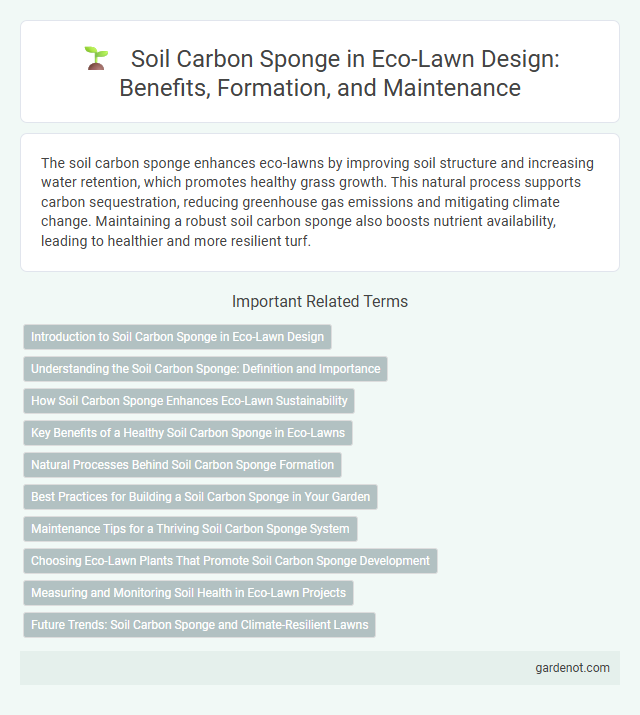The soil carbon sponge enhances eco-lawns by improving soil structure and increasing water retention, which promotes healthy grass growth. This natural process supports carbon sequestration, reducing greenhouse gas emissions and mitigating climate change. Maintaining a robust soil carbon sponge also boosts nutrient availability, leading to healthier and more resilient turf.
Introduction to Soil Carbon Sponge in Eco-Lawn Design
Soil carbon sponge in eco-lawn design refers to the highly porous, organic matter-rich layer within the soil that enhances water retention, nutrient cycling, and microbial activity. This sponge-like soil structure improves drought resistance and supports healthy turf growth by increasing soil aeration and moisture storage capacity. Integrating soil carbon sponges in eco-lawns reduces irrigation needs and promotes sustainable lawn management.
Understanding the Soil Carbon Sponge: Definition and Importance
The soil carbon sponge refers to the porous structure of soil enriched with organic carbon that enhances water retention, nutrient availability, and microbial activity. This biologically active matrix plays a crucial role in improving soil fertility, supporting plant growth, and mitigating climate change by sequestering atmospheric carbon dioxide. Understanding the dynamics of the soil carbon sponge is essential for sustainable land management practices, especially in the development of eco-lawns that promote ecosystem resilience and reduce environmental impacts.
How Soil Carbon Sponge Enhances Eco-Lawn Sustainability
Soil carbon sponge improves eco-lawn sustainability by increasing soil organic matter, which enhances water retention and reduces runoff. This enhanced soil structure supports healthy turfgrass growth while minimizing the need for irrigation and chemical fertilizers. Boosting soil carbon sequestration also contributes to mitigating climate change impacts associated with lawn care.
Key Benefits of a Healthy Soil Carbon Sponge in Eco-Lawns
A healthy soil carbon sponge in eco-lawns enhances water retention, reducing irrigation needs by up to 50% and improving drought resilience. It boosts soil fertility through increased organic matter, promoting robust grass growth and capturing more atmospheric carbon. This natural process supports biodiversity, decreases erosion, and fosters a sustainable, low-maintenance lawn ecosystem.
Natural Processes Behind Soil Carbon Sponge Formation
Soil carbon sponge formation relies on natural processes such as photosynthesis, where plants convert atmospheric carbon dioxide into organic matter that enriches the soil. Microbial activity decomposes this organic material, creating stable soil aggregates that enhance water retention and aeration. The accumulation of humus and root biomass contributes to a porous soil structure, improving soil fertility and resilience in eco-lawn environments.
Best Practices for Building a Soil Carbon Sponge in Your Garden
Incorporating organic mulch, cover crops, and diverse plant roots enhances soil structure and increases soil organic carbon, effectively creating a resilient soil carbon sponge. Regular incorporation of compost and minimizing soil disturbance promotes microbial activity and improves water infiltration and retention. Adopting rotational planting and maintaining soil moisture optimize carbon sequestration and support healthy, nutrient-rich soil ecosystems in your eco-lawn.
Maintenance Tips for a Thriving Soil Carbon Sponge System
Maintaining a thriving soil carbon sponge system requires regular organic matter additions such as compost and mulch to enhance soil structure and increase carbon sequestration. Frequent aeration through practices like core aeration promotes microbial activity and improves water infiltration. Monitoring soil moisture levels and avoiding excessive tillage protect the porous soil network essential for sustaining a healthy carbon sponge.
Choosing Eco-Lawn Plants That Promote Soil Carbon Sponge Development
Selecting eco-lawn plants such as native deep-rooted grasses and legumes enhances soil carbon sponge development by increasing organic matter and improving soil structure. These plants encourage microbial activity and root biomass accumulation, which boosts soil carbon sequestration and water retention capacity. Incorporating species like buffalo grass, clover, and fescue supports a resilient, carbon-rich soil ecosystem essential for sustainable lawn management.
Measuring and Monitoring Soil Health in Eco-Lawn Projects
Measuring and monitoring soil health in eco-lawn projects involves assessing soil carbon sponge capacity, a critical indicator of soil's water retention and carbon sequestration abilities. Techniques such as soil respiration tests, bulk density measurements, and organic matter content analysis provide quantitative data on soil carbon levels and microbial activity. Regular monitoring enables adaptive management to enhance soil structure, promote biodiversity, and improve overall ecosystem resilience in eco-lawn environments.
Future Trends: Soil Carbon Sponge and Climate-Resilient Lawns
Soil carbon sponge technology enhances soil's ability to retain moisture and sequester carbon, promoting climate-resilient lawns that withstand drought and heat stress. Current research highlights increasing organic matter and microbial activity as key factors in developing robust soil carbon sponges within eco-lawns. Future trends focus on integrating biochar amendments and regenerative landscaping practices to optimize carbon storage and improve lawn sustainability amid changing climate conditions.
Soil carbon sponge Infographic

 gardenot.com
gardenot.com